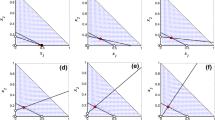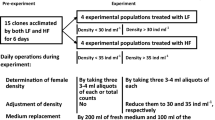Abstract
In the ecological stoichiometry theory of population dynamics, ontogenetic changes in nutrient demand have been ignored. Here, I studied a stage-structured Daphnia–algae herbivore–autotroph model, in which the juveniles of the herbivore had a higher nutrient (phosphorous) demand for maturation than the adults for reproduction. The model predicted that while an increase in the juvenile nutrient demand (i.e., ontogenetic stoichiometric bottleneck) affects stage-specific performances in complex ways through nutrient dynamics and resource quality, in general it has stabilizing effects on the population dynamics.



Similar content being viewed by others
References
Andersen T (1997) Pelagic nutrient cycles: herbivores as sources and sinks. Springer, Berlin
Andersen T, Elser JJ, Hessen DO (2004) Stoichiometry and population dynamics. Ecol Lett 7:884–900. doi:10.1111/j.1461-0248.2004.00646.x
Becker C, Boersma M (2003) Differential effects of phosphorus and fatty acids on Daphnia magna growth and reproduction. Limnol Oceanogr 50:388–397
Carrillo P, Villar-Argaiz M, Medina-Sánchez JM (2001) Relationship between N:P ratio and growth rate during the life cycle of calanoid copepods: an in situ measurement. J Plankton Res 5:537–547
De Roos AM, Schellekens T, Van Kooten T, Van De Wolfshaar K, Claessen D, Persson L (2007) Food-dependent growth leads to overcompensation in stage-specific biomass when mortality increases: the influence of maturation versus reproduction regulation. Am Nat 170:E59–E76. doi:10.1086/520119
De Roos AM, Schellekens T, Van Kooten T, Van De Wolfshaar K, Claessen D, Persson L (2008) Simplifying a physiologically structured population model to a stage-structured biomass model. Theor Popul Biol 73:47–62. doi:10.1016/j.tpb.2007.09.004
DeMott WR (2003) Implications of element deficits for zooplankton growth. Hydrobiologia 491:177–184. doi:10.1023/A:1024408430472
DeMott WR, Gulati RD, Siewertsen J (1998) Effects of phosphorus deficient diets on the carbon and phosphorus balance of Daphnia magna. Limnol Oceanogr 43:1147–1161
Elser JJ, Sterner RW, Gorokhova E, Fagan WF, Markow TA, Cotner JB, Harrison JF, Hobbie SE, Odell GM, Weider LW (2000) Biological stoichiometry from genes to ecosystems. Ecol Lett 3:540–550. doi:10.1111/j.1461-0248.2000.00185.x
Elser JJ, Acharya K, Kyle M, Cotner J, Makino W, Markow T, Watts T, Hobbie S, Fagan W, Schade J, Hood J, Sterner RW (2003) Growth rate–stoichiometry couplings in diverse biota. Ecol Lett 6:936–943. doi:10.1046/j.1461-0248.2003.00518.x
Færøvig PJ, Hessen DO (2003) Allocation strategies in crustacean stoichiometry: the potential role of phosphorus in the limitation of reproduction. Freshwat Biol 48:1782–1792. doi:10.1046/j.1365-2427.2003.01128.x
Grover JP (2003) The impact of variable stoichiometry on predator–prey interactions: a multinutrient approach. Am Nat 162:9–43. doi:10.1086/376577
Hall SR (2009) Stoichiometrically explicit food webs: feedbacks between resource supply, elemental constraints, and species diversity. Annu Rev Ecol Evol Syst 40:503–528. doi:10.1146/annurev.ecolsys.39.110707.173518
Hessen DO (1990) Carbon, nitrogen and phosphorus status in Daphnia at varying food conditions. J Plankton Res 12:1239–1249
Hessen DO, Andersen T (1992) The algae–grazer interface: feedback mechanisms linked to elemental ratios and nutrient cycling. Arch Hydrobiol 35:111–120
Main T, Dobberfuhl DR, Elser JJ (1997) N:P stoichiometry and ontogeny in crustacean zooplankton: a test of the growth rate hypothesis. Limnol Oceanogr 42:1474–1478
Moe SJ, Stelzer RS, Forman MR, Harpole WS, Daufresne T, Yoshida T (2005) Recent advances in ecological stoichiometry: insights for population and community ecology. Oikos 109:29–39. doi:10.1111/j.0030-1299.2005.14056.x
Murdoch WW, Briggs CJ, Nisbet RM (2003) Consumer–resource dynamics. Princeton University Press, Princeton
Nakazawa T, Ohgushi T, Yamamura N (2009) Resource-dependent reproductive adjustment and the stability of consumer–resource dynamics. Popul Ecol 51:105–113. doi:10.1007/s10144-008-0101-9
Persson J, Fink P, Goto A, Hood JM, Jonas J, Kato S (2010) To be or not to be what you eat: regulation of stoichiometric homeostasis among autotrophs and heterotrophs. Oikos 119:741–751. doi:10.1111/j.1600-0706.2010.18545.x
Pilati A, Vanni MJ (2007) Ontogeny, diet shifts, and nutrient stoichiometry in fish. Oikos 116:1663–1674. doi:10.1111/j.2007.0030-1299.15970.x
Sterner RW, Elser JJ (2002) Ecological stoichiometry: the biology of elements from molecules to the biosphere. Princeton University Press, New Jersey
Sterner RW, Schulz KL (1998) Zooplankton nutrition: recent progress and a reality check. Aquat Ecol 32:261–279. doi:10.1023/A:1009949400573
Urabe J, Sterner RW (2001) Contrasting effects of different types of resource depletion on life-history traits in Daphnia. Funct Ecol 15:165–174. doi:10.1046/j.1365-2435.2001.00511.x
Villar-Argaiz M, Sterner RW (2002) Life history bottlenecks in Diaptomus clavipes induced by phosphorus-limited algae. Limnol Oceanogr 47:1229–1233
Villar-Argaiz M, Medina-Sánchez JM, Carrillo P (2002) Linking life history strategies and ontogeny in crustacean zooplankton: implications for homeostasis. Ecology 83:1899–1914. doi:10.1890/0012-9658(2002)083[1899:LLHSAO]2.0.CO;2
Vrede T, Dobberfuhl DR, Kooijman SALM, Elser JJ (2004) Fundamental connections among organism C:N:P stoichiometry, macromolecular composition, and growth. Ecology 85:1217–1229. doi:10.1890/02-0249
Acknowledgments
Satoshi Kato and anonymous reviewers provided helpful comments on this manuscript. This research was supported by a Japan Society for the Promotion of Science Research Fellowship for Young Scientists (2103033) and Excellent Young Researchers Overseas Visit Program.
Author information
Authors and Affiliations
Corresponding author
Appendices
Appendix 1
In this Appendix, I present some results with different parameter settings to test the robustness of the stabilizing effects of OSB. I examined the steady state of the system along a nutrient gradient N T for different levels of the juvenile nutrient demand q J (as in Fig. 1) by varying one parameter value and keeping the other parameters to the default values (see text). As examples, here I varied light-induced carrying capacity K (~1.5), herbivore mortality rate μ (~0.05), dilution rate d (~0.05), stage-specific resource availability ratio α (~2) or birth-to-maturity body mass ratio z (~0.05). In any case, I found that an increase in q J significantly stabilized the system (i.e., the bifurcation boundary shifted upward and the parameter region for stable coexistence increased). I also obtained qualitatively the same results when other parameter values were varied (results not shown). Therefore, it seems that the stabilizing effects of OSB are robust within the biologically meaningful parameter space. Notation is identical to that in Fig. 1.

Appendix 2
Here, I show that the stabilizing effects of OSB would be qualitatively robust regardless of which stage has a higher nutrient demand. I examined the steady state of the system along a nutrient gradient N T for different sets of (q J, q A) including situations where the adults had a higher P demand than the juveniles. I found that an increase in either q J or q A stabilized the system (i.e., the bifurcation boundary shifted upward and the parameter region for stable coexistence increased). The stabilizing effects of increasing q J (or q A) were larger when q A (or q J) was small. Panels are arranged along q J (column) and q A (row) (q h = 0.01, 0.015, 0.02 or 0.03). Notation is identical to that in Fig. 1.

About this article
Cite this article
Nakazawa, T. The ontogenetic stoichiometric bottleneck stabilizes herbivore–autotroph dynamics. Ecol Res 26, 209–216 (2011). https://doi.org/10.1007/s11284-010-0752-9
Received:
Accepted:
Published:
Issue Date:
DOI: https://doi.org/10.1007/s11284-010-0752-9




